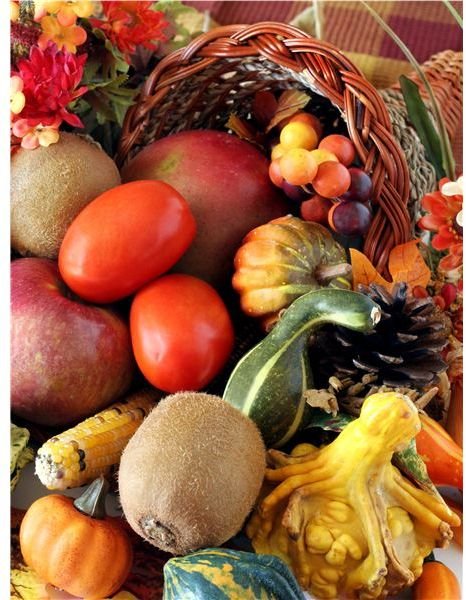Thematic Teaching Unit on Vegetables: Math, Art & Science Activities for Grade School Students
Make Vegetables a New Favorite
For many students, the word “vegetable” conjures up pictures of mushy green glop on a plate. When students study the characteristics
of produce, however, they begin to understand that there might be more to veggies than that. Add a little fun with art projects, and suddenly vegetables don’t seem like villains to be fought or avoided. Let your students learn to love vegetables with their own cookbook, as well.
Making Math With Produce
Objectives
-
Students will review whole number operations by applying their skills to solving vegetable-themed word problems.
-
Students will practice operations with fractions by converting vegetable recipes for more or fewer servings.
Procedure
Help students practice basic operations (addition, subtraction, multiplication, division) by providing vegetable-themed word problems.
For example, ask students to set up and solve stories like: Mike wants to plant 2 acres of lettuce and 3 acres of tomatoes. If it takes 150 lettuce plants and 75 tomato plants for each acre, how many of each kind of plant will Mike need?
Extend the lesson by having students write and illustrate their own problems to exchange with a partner for solving.
Provide students with several recipes for vegetable dishes, some of which have common ingredients. Ask them to convert eight-serving recipes to serve four people or to serve the class. Follow this by having students compile a shopping list for all of their converted recipes, combining amounts for ingredients found in more than one recipe. Provide grocery circulars from the newspaper or price lists that you have created and ask students to calculate the cost of preparing the dishes.
Shaping Art from Vegetables
Objectives
Students will experience using a variety of materials to produce stamped items.
-
Students will combine various vegetables to make animal sculptures.
-
Students will use seeds to make mosaics of vegetables to illustrate a My Favorite Vegetables book.
Procedure
Allow students to use cut vegetables and paint them to make vegetable collages or gift-wrap. Some vegetables work best when simply sliced flat, such as pepper rings, but others, like carrots and potatoes, can be carved into stars or other shapes before being dipped into paint. Save some of the single prints for a writing assignment to follow.
Ask students to bring a variety of vegetables to share. Provide toothpicks and encourage them to combine the items to make Produce Pals. Larger veggies like potatoes, eggplant and tomatoes work well for bodies and heads, while celery, carrots, zucchini and other long ones make arms and legs. Broccoli and cauliflower get in on things as hair or limbs, as well.
Print vegetable outlines on cardstock. Student should “paint” the inside with glue watered to a paint consistency and then place or sprinkle seeds to fill the shape in a visually appealing mosaic pattern.
Fruit or Vegetable? Science Activities
Objectives
-
Students will compare the characteristics of vegetables and fruits.
-
Students will observe, describe and draw the parts and life cycle of vegetables.
-
Students will observe the capillary effect in some vegetables.
-
Students will explore the needs of vegetable plants.
Procedure
Discuss the botanical definition of a fruit with students and explain that the definition of a vegetable is more a folk term than a scientific one. Ask them to create Venn diagrams to compare and contrast vegetables and fruits. Extend the lesson by having the students use their diagrams to write compare/contrast essays.
“Plant” vegetable seeds in resealable plastic bags by placing the seeds between the side of the bag and a dampened paper towel. Ask students to observe and record the changes each day. At the end of the project, ask students to sketch and label the plant’s parts before they transplant it to soil.
Help students understand how the roots and veins of plants work by “dying” celery with food coloring. Place a stalk of celery, with the bottom 1/4- to 1/2-inch removed (but preferably with the leaves remaining), into a glass containing water and food coloring. Ask students to record their observations as the color rises into the stalk and leaves.
Divide students into pairs and provide each with matching vegetable plants (2 tomato plants, 2 bell peppers, etc.). Each pair should design and carry out an experiment to determine the effect of watering, feeding, light or other elements on their plants, using one as a control. For example, one group might water one plant with tap water and the other with a different liquid; a group might place a plant near the window and another in a closed cabinet.
Tomatoes, Potatoes, and Writing! Oh, My!
Objectives
-
Students will practice descriptive writing.
-
Students will demonstrate research skills.
Procedure
Allow students to brainstorm as a large group or smaller partnerships to create lists of descriptive words and phrases for different vegetables. After they have completed the stamping project, have them carefully cut out the stamped vegetable shape and write shaped poems on the back, describing the vegetable from which the print was made. Extend the lesson by asking them to include facts about the vegetable (nutrition, history, uses) in addition to the physical, sensory description.
Provide students with a list of vegetables, including many that might not be as familiar, such as kohlrabi. Working in pairs, students should research the vegetables and write a short encyclopedia-style passage about it, as well as two or three recipes for the vegetable. Partners then create a page for a class vegetable cookbook; the page should include the informative paragraph, the recipes and some illustrations.
With these thematic teaching units on vegetables, spinach and broccoli may be lifted to whole new levels of respect.
Resources
For more information about the difference between fruits and vegetables, check out:
Diffen.com: Fruit vs Vegetable
Argonne National Library’s Newton, Ask a Scientist – Vegetables, Fruit, etc. Defined
Ideas for the lessons here come from the author’s many years as a classroom teacher.
